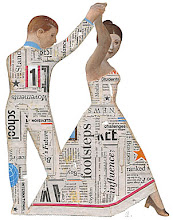 Yesterday I picked up a copy of Vibrations: Chinese Chippendale by Gerald William Covey. This is far-and-away one of my all-time favorite book finds. Covey was born in Milledgeville, Ga and bopped around in the Navy, studied 'the graphic arts,' poetry, chiropractics, and aerospace physiology.
Yesterday I picked up a copy of Vibrations: Chinese Chippendale by Gerald William Covey. This is far-and-away one of my all-time favorite book finds. Covey was born in Milledgeville, Ga and bopped around in the Navy, studied 'the graphic arts,' poetry, chiropractics, and aerospace physiology.
The poems are a "portamental portfolio" arranged in a formal concert, where different colors represent different notes. Below is the color code Covey created with a footnote that the "the color red is considered vulgar in some societies."

I copied out a poem (below) called "Windchimes" and tried to remain as true to the form as possible. Every poem begins with concert instructions/notations and ends with a time/date stamp.
Campanile I:
Cappriccio I:Deja vu VI:
Divertissement II:
Pas Seul:
Danseur: Leo:
(tiger)Windchimes
Ching. China samisens sing.
Whirlwinds wind songs,
Fonging, tonging, zonging,
Hong Kong's bongs and gongs.Ping. Porcelain windpipes ling.
Timbal clicks:
A Bengal tiger in a forest of copper tibre,
Holds timbel,
Brass rings in a Tigerbalm garden of Victorian splendor.Ring. Bronze glockenspiels bing.
Kowloon junks trunk,
Chunks of sandpan,
Cinnabar brindges of Aberdeen.Sing. Silver celestras Qing.
Timbrel licks,
Of Chinese coins,
Timber yen and tick.Ting. Tin tubular bells wing.
Timbre Styx.
Of Pompeian cameos,
Chopped with shillings,
Pyxed with farthings,
Nicked with crowns,
Profile of a British queen.Wing. Wooden xylophones Ming.
Victoria, Hong Kong China, Asia
Circa 1970
There is also an extensive glossary of terms found at the end of the concert. Here's where all the musical terms are defined, languages are translated, Greek and Roman references explained. It's this beautiful attempt at an absolutely transparent complexity.

What an endeavor. I just had to copy out Appendix III to give you the right idea:
"The author, being born in Washington D.C., in 1944;
having traveled extensively through many cities throughout the globe; being a native of Milledgeville, Georgia, and having been fortunate to attend various centers of higher learning here in the United States, is now a patron of the arts and writes with the plural purposes of honorably promoting the fine arts to all classes of people, regardless of economic level, by offering art in a medium which most can afford and of adventurously promoting the cultures of minority groups (including minority ethnic groups and socially oppressed peoples) in an effort to achieve a more complete understanding and acceptance between various cultural and social groups (The promotion of the higher arts or any art to only the socially privileged is useless in developing an appreciation of the higher arts among the socially deprived.); the author feels that art for art's sake is an insult to the artist and a sham to those who are seeking entertainment as well as environmental improvement; after all, the purpose of any art is to tell or remind man (humanity) that he, above all else on Earth, is a gifted creature, regardless of his imperfections, having the power to benefit himself even in the face of uncertain fate."
Throughout the book there are little marks and spelling corrections. At first I didn't think anything of it until I saw this note on the last page:





No comments:
Post a Comment